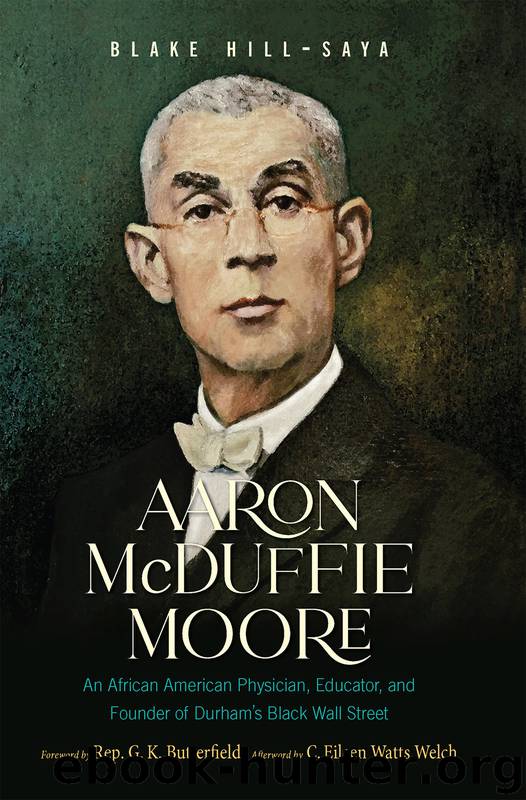Aaron McDuffie Moore by Blake Hill-Saya

Author:Blake Hill-Saya
Language: eng
Format: epub
Publisher: The University of North Carolina Press
Published: 2020-05-25T16:00:00+00:00
15
FOR OUR MUTUAL BENEFIT
Forging the Mighty Triumvirate
The North Carolinian newspaper of Thursday, December 22, 1898, printed, “This morning, about 3:45 o’clock, fire destroyed a stable belonging to Dr. A. M. Moore, colored, in the negro settlement here. The loss will amount to about $100 with no insurance.”1
Fire was a dangerous foe in America at the turn of the century. There were many causes, some of which, during these violent times in racial politics, were highly suspect. The cause of the fire at Moore’s stable is unknown, but it must have been a fairly severe hardship monetarily, especially if any animals, feed, modes of transport, or equipment were lost. It surely would have been frightening to all concerned, regardless of cause, just a month after the Wilmington coup. Once the barn fire was out and the damage assessed, Dr. Moore and his family would need to either rebuild or relocate. What a nuisance just before Christmas and, as the paper noted, with no insurance.
Insurance was a luxury that was not readily available to black people during this era. For many years during and after Reconstruction, Southern black communities found their only source of stabilizing financial and social infrastructure in the church or in various fraternal orders. Some of these fraternal orders were elaborate, stylized, and secretive; others were practical and recognized forums for community organization, much like a chamber of commerce. As fraternal orders grew, some of them also functioned as banks and loan centers for black customers, and some even had rudimentary insurance benefits for widows’ funds and funeral expenses. John Merrick, who had been part of purchasing the national charter of such an order (the Royal Knights of King David) for Durham’s Hayti, was also an active member of a larger fraternal order based in Virginia: the Grand United Order of True Reformers. This order was originally founded on the principle of temperance but became much more influential, especially in the 1890s under the guidance of William Washington Brown. Brown died in 1897, but not before he and the True Reformers had influenced a new wave of black entrepreneurs like John Merrick. The establishment of insurance companies that could support black families with more than a one-time death benefit was a popular platform of the True Reformers, as was the establishment of a secure and self-sustaining black middle class.2 Walter Weare remarks in his book on the history of black businesses in the new South that “what evidence there is suggests that virtually every insurance association founded in the Upper South during the late nineteenth and early twentieth centuries can be traced to ex–True Reformer agents who organized their own societies. … Indeed, this is precisely what happened in the case of the North Carolina Mutual.”3
John Merrick is often apocryphally credited with being tired of people coming to his barbershop to take up collections for widows, fires, and funerals. This characterization may have been true, but his long-standing activity with these influential fraternal orders gives his ideas concerning racial uplift through insurance and infrastructure development a bit more context.
Download
This site does not store any files on its server. We only index and link to content provided by other sites. Please contact the content providers to delete copyright contents if any and email us, we'll remove relevant links or contents immediately.
| Africa | Asia |
| Canadian | Europe |
| Holocaust | Latin America |
| Middle East | United States |
Fanny Burney by Claire Harman(26526)
Empire of the Sikhs by Patwant Singh(22974)
Out of India by Michael Foss(16790)
Leonardo da Vinci by Walter Isaacson(13179)
Small Great Things by Jodi Picoult(7019)
The Six Wives Of Henry VIII (WOMEN IN HISTORY) by Fraser Antonia(5394)
The Wind in My Hair by Masih Alinejad(5033)
A Higher Loyalty: Truth, Lies, and Leadership by James Comey(4840)
The Lonely City by Olivia Laing(4746)
The Crown by Robert Lacey(4722)
Millionaire: The Philanderer, Gambler, and Duelist Who Invented Modern Finance by Janet Gleeson(4374)
The Iron Duke by The Iron Duke(4291)
Papillon (English) by Henri Charrière(4195)
Sticky Fingers by Joe Hagan(4100)
Joan of Arc by Mary Gordon(4013)
Alive: The Story of the Andes Survivors by Piers Paul Read(3967)
Stalin by Stephen Kotkin(3875)
Aleister Crowley: The Biography by Tobias Churton(3586)
Ants Among Elephants by Sujatha Gidla(3417)
